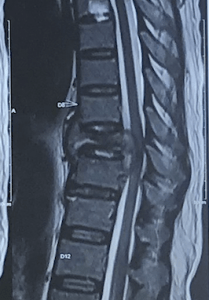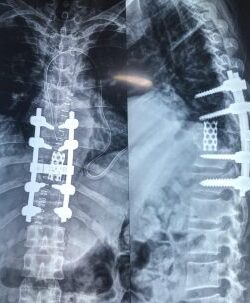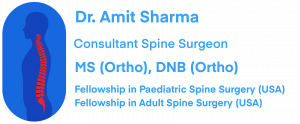Spinal Tuberculosis (TB)
Spinal Tuberculosis Symptoms and Treatment
Spine is most commonly affected bone by tuberculosis infection. It primarily affects thoracic spine; however, tuberculosis of lumbar spine, cervical spine and sacrum are not uncommon. Primary lesion in spine tuberculosis is infection of the disc and adjacent vertebral bones. This gradually involves vertebral bodies causing destruction and collapse of vertebra. Occasionally, infection starts in vertebral body or posterior part of bony vertebral ring. Spinal tuberculosis can also involve spinal cord and it’s coverings (Meninges).
Spine Tuberculosis Symptoms:
Patients usually presents with pain at the site of infection. Typical symptoms of tuberculosis (fever, night sweat, loss of appetite, weight loss) are many times absent in spinal tuberculosis. If vertebral destruction is significant, patient may have localized deformity (kyphosis) at that level. In advance cases, patients may have symptoms of spinal cord compression (loss of sensation and weakness in arms/ legs, loss of bladder-bowel control, loss of dexterity and weakness in hand grip, loss of balance and spasticity in legs), which happens due to compression by:
- Displaced bone fragments from vertebral body destruction and collapse,
- Pus and granulation tissue in spinal canal,
- Compression of spinal cord by deformed spine,
- Direct involvement of spinal cord by infection
Causes of Spinal Tuberculosis:
- Contact with person having tuberculosis
- Poor nutrition,
- Living in overcrowded places,
- Debilitating medical illnesses,
- Immunosuppressant therapy,
- HIV and other illnesses suppressing immunity.
Spinal Tuberculosis Diagnosis:
Any patient presenting with above-mentioned signs and symptoms and having risk factors should be suspected of having spine tuberculosis. A thorough physical examination with special attention to neurological status is done. Following tests are recommended for final diagnosis confirmation:
- X-ray: An x-ray will show loss of disc height in early phase of disease as spinal tuberculosis usually starts with involvement and destruction of the disc material. It will also reveal vertebral collapse and spinal deformity in advanced cases.
- MRI Scan: An MRI is usually done early in cases suspected to be having spinal tuberculosis. It will reveal infection affecting disc and adjacent vertebral bodies in detail. Vertebral body destruction, amount of spinal cord compression, presence of infection at other levels, infection inside the spinal cord will also be evident on an MRI. MRI is also done to assess patient’s response to treatment. Though spinal tuberculosis has typical MRI picture, it cannot confirm whether it is tuberculosis, or bacterial infection, or some other lesion. A biopsy is required for that.
- Biopsy: A biopsy of the lesion seen on MRI is of great importance. It will give us final confirmation about the diagnosis of the lesion. A microscopic histopathology examination will differentiate between infection due to bacteria/ tuberculosis and a tumor. Collected sample is also used for culture and sensitivity to know which antibiotics will work on given infection. There are different ways to collect biopsy:
- CT Guided Biopsy: A needle is inserted under local anesthesia with CT guidance and required material is retrieved.
- Fluoroscopy Guided Biopsy: Under local/ general anesthesia, target material is collected with help of intra-operative x-ray TV machine. This procedure is done in operation theater.
- Surgical Biopsy: Sample is collected by surgical intervention when 1) previous biopsy attempts have failed, 2) it is difficult to reach the lesion by CT/ Fluoroscopy, 3) when surgery is any way required for other reasons.
- CT Scan: A CT is performed to assess bony anatomy in detail and when MRI is not possible. CT scan is also used to assess bone healing in post-operative patients.
- Culture and Sensitivity: Tuberculosis can be of different kind based on the antibiotics it responds to. To know whether it’s a normal/ multi drug resistant (MDR)/ extreme drug resistant (XDR) TB and to guide spine specialist to choose right medications, a culture and sensitivity test is done. In this test bacteria is first grown in lab and then different drugs are tested on this to see which drugs inhibit growth of the bacteria. Those same drugs are then given to patient to treat him/ her.
- Other tests: A chest x-ray and sputum test is done to rule out lung infection. Several blood tests (e.g. ESR) can be done to assess severity and progress/ resolution of infection.
Spinal Tuberculosis Treatment:
Spine TB Medicine:
TB is a medical disease. Even if a surgery is done, it is absolutely must to take spine tuberculosis drugs to eradicate TB infection. TB bacteria responds slowly to drugs, hence a long duration of treatment is required. This may range from 12 -24 months depending on the type of infection (resistant TB versus normal TB), response to drugs, site of infection etc. For patients who are diagnosed in early phase, and who do not have any indication for surgery (please see below), a medical treatment with appropriate drugs is usually sufficient. This should be accompanied by good nutrition, adequate rest, bracing of the affected spine segment, symptomatic treatment for pain and nutritional supplements. A close watch on patient’s response to drug therapy is necessary by clinical examination, blood tests and imaging to ensure gradual resolution of the patient’s symptoms/ progressive healing of the lesion and to catch any complication caused by medicines/ disease process to treat them early.
Spine Tuberculosis Surgery:
Spine Tuberculosis Surgery is required when patient presents with any of the followings, either at first presentation or during the course of medical treatment:
- Signs of severe spinal cord compression (loss of sensation and weakness in arms/ legs, loss of bladder-bowel control, loss of dexterity and weakness in hand grip, loss of balance and spasticity in legs),
- Progressive worsening of spinal cord compression symptoms during treatment,
- X-ray/ MRI evidence of severe bone destruction which can cause spine instability, increased pain, deformity and spinal cord compression,
- Severe pain not responding to medical treatment,
- To obtain biopsy in difficult cases.
Usually a spine decompression and fusion surgery is required in these cases. Spine fusion will give pain relief, correct and prevent progression of spine deformity, allow adequate spinal decompression to take place and prevent recurrence of spinal stenosis, stabilize spine to help in infection healing, allow early mobilization and prevent need of bed rest after surgery. In rare instances, where vertebral destruction is not significant and primary symptoms are of spine stenosis, a decompression only procedure can be done. Also, a TB lesion inside the spinal cord might also need only decompression surgery if not responding to medical treatment/ and to confirm diagnosisspine
If you’re seeking expert care for spinal tuberculosis in Mumbai, it’s essential to connect with a seasoned Spine TB specialist. With a wealth of experience in diagnosing and treating this condition, our Spine TB specialists in Mumbai are dedicated to providing top-notch care to patients like you. Whether you’re looking for a specific Spine TB specialist near you or require a comprehensive approach to your spinal tuberculosis treatment, we’re here to guide you. Our team of experienced physicians is well-equipped to address your needs, helping you embark on the path to recovery with confidence and peace of mind. Your journey to better health starts with expert care, and we’re here to ensure you receive it.
Please contact us on +91-9967600461 for any query


Frequently asked questions:
Spinal tuberculosis recovery time can vary significantly based on factors such as the severity of the condition, individual response to treatment, and whether surgery is required. In most cases, treatment extends for several months, and some patients may continue to experience recovery for a year or more after completing medication. The exact timeline should be determined by your healthcare provider based on your specific case.
Spinal tuberculosis typically progresses through stages. The initial stage involves active infection, which can cause symptoms like back pain and fatigue. Subsequent stages encompass the healing process and recovery. Accurate staging is determined through clinical assessment and diagnostic imaging, guiding the appropriate treatment plan.
Bed rest is often recommended during the early stages of spinal tuberculosis treatment. The duration of bed rest can vary but usually lasts for several weeks to months. It helps reduce strain on the spine and promotes healing. However, the specific duration should be advised by your healthcare provider based on your condition.
In some cases of spinal tuberculosis, healthcare providers may recommend limited physical activity and advise against walking during the active phase of the disease. This is to prevent further complications and promote effective treatment. It is crucial to follow your healthcare provider’s guidance regarding physical activity restrictions. Also, patients with paralysis secondary to spinal cord compression in spine TB will not be able to walk until complete recovery takes place.
Spinal tuberculosis recovery may involve residual symptoms, such as mild back pain or fatigue. These symptoms can vary from person to person and may persist during the healing process. It’s essential to communicate any ongoing symptoms with your healthcare provider for appropriate management.
The recovery time after spinal tuberculosis surgery depends on the extent of the procedure and individual factors. Patients typically require several weeks to months for rehabilitation and recovery. Your healthcare provider can provide a more accurate estimate based on your specific surgery and condition.
The primary treatment for spinal tuberculosis involves a combination of antitubercular drugs, including isoniazid, rifampicin, pyrazinamide, and ethambutol. These medications are prescribed by healthcare professionals and should be taken as directed throughout the treatment period.
Yes, back pain can be a common symptom of spinal tuberculosis. Some patients may continue to experience back pain during the course of TB treatment as the body heals and the infection is cleared. If the pain is severe or worsening, it’s important to report it to your healthcare provider for assessment.
The treatment duration for spinal tuberculosis can be quite lengthy, often spanning several months to a year or more. The extended duration is necessary to ensure the complete eradication of the infection and to promote a full recovery.
While antitubercular drugs are essential for treating spinal tuberculosis, they can have side effects. These can range from mild to severe and may include liver toxicity, gastrointestinal disturbances, and neurological effects. Close monitoring by a healthcare provider is crucial to manage and address any side effects promptly.
The cost of spinal tuberculosis surgery can vary significantly depending on the type of surgery required, the location, the healthcare facility, and associated expenses. It’s advisable to consult with your healthcare provider and insurance company for cost estimates and coverage details.

Please educate me more about spinal TB
Please ask if you have any specific question in your mind.
My 21 year old female family member suffering from spine tb has got cold abscess on sub costal area . Dr decided and did incession and drainage 2 months ago and strarted ATT. After I&S puss discharge gradually reduced and the discharge was thick.
But from last week the quantity of discharge has again increased and the discharge is relatively thin in consistency.
Pls. Guide me is it normal or its something wrong.
In the beginning of spinal TB treatment, pus discharge can happen. If it is TB discharge only, usually it subsides in few days/ weeks. However, we need to rule out any super-added bacterial infection by sending cvulture and sensitivity of the pus discharge.
My father had tuberculosis of the spine and as a result part of his spine had eroded away without bone. Please help me what should I do to fix this(என் தந்தைக்கு முதுகுத்தண்டில் காசநோய் இருந்தது, அதன் விளைவாக அவரது முதுகுத்தண்டின் ஒரு பகுதி எலும்பு இல்லாமல் அரிக்கப்பட்டு விட்டது. இதை சரிசெய்ய நான் என்ன செய்ய வேண்டும் என்று எனக்கு உதவவும்)
Surgery is required if 1) too much bone is eroded, 2) there is significant pain, 3) patient is not responding to medical treatment, 4) there is numbness or weakness in legs. Please send your father’s MRI pictures on draks777@gmail.com to give you final decision.
Am Bartha
I was diagnosed with spine tb 5months now but two of my bones were eaten up with the tb infection but at first I used to stand up straight and walk well when those bones were not in shape but as time is going on I can’t move straight am all bending while making movements .. am consulting if I can walk straight again without the surgery??? Or I need surgery?? And can I heal fully ?? Won’t the surgery bring permanent pain to me ??please help me
Please send all reports on draks777@gmail.com
I am a stage5 spine tb patient.Can I walk again?I was in bed all time for 5 months.Can I be alive?
Please send all reports on draks777@gmail.com
Hello, I am Nurul, 32 years old. 5 months ago I had undergone spinal surgery in t4 to t7 region for tuberculosis. I was partially Paralysed in lower parts of the body for 5 day before identifying TB. After surgery, now I can walk and taking physiotherapy. But I am suffering some problems.
1. Urinary incontinence (urine retention, overactive bladder, very poor urine flow). Urologist said neurogenic bladder due to spinal tb.
2. After 5 months of tb treatment, I feel mild numbness at my finger.
Question:
* will urinary incontinence be cured?
* can spinal tb spread fresh region of spine during treatment? Note that I am taking tb medicine regularly without missing.
Please help to reply 🙏.
Please send all reports on draks777@gmail.com
Meri behn ka spine tb ka operation hua hai but operation k baad b pus reh chuki hai or dwai chal rhi hai or paraplegia b hai kya dobara operation krwana pdega pus k liye
Please send all reports on draks777@gmail.com
Hello sir,
I am a Multiple Sclerosis patient and have been suffering from this illness since November 2015. I was advised for Azoron in 2016, along with essential steroid tablets.
Again, after the 2017 relapse, I started to experience severe back pain. But unfortunately, no MRI showed the correct imaging studies.
Finally, in 2019, I was diagnosed with Pott spine (Spine TB), and the mycobacterium entirely ate my three dorsal discs.
I took TB treatment for over five months, and for the pain, I was advised to undergo surgery.
2019 MRI showed Gibbus deformity. Again, an MRI was taken in 2022 after completing the TB meds.
My pain is tedius and I could not bear the pain at all.
Pls, advise me in this regard.
Thanks
Lakshmi S
Have you undergone surgery? If not, its better to get it done.
Please send latest reports on draks777@gmail.com
My mother has diagnosed with spine tb …. doctor confirm its from mri report….at the same time she has a lot of pain in back when she walk or sit she can’t sit more than 5 min but when she lying on bed there is no pain what to do
Nothing else no leg weaknes no numbness
I send u mri report also
She start tb medicine from 3 may 2024
Has a biopsy been done to know culture and sensitivity of the TB bacteria?
Biopsy is not recommended by doctor
My wife had spine TB and underwent surgery on November 2017, post surgery she is been suffering severe burning pain in back , also she has issues with her grip , compression in her spin and it was bent , appetite loss, hand pulling pain , … She is been suffering since post surgery.
What are the treatment can be done to take away her pain..
Can you please help us.
Can you please send her latest reports on draks777@gmail.com